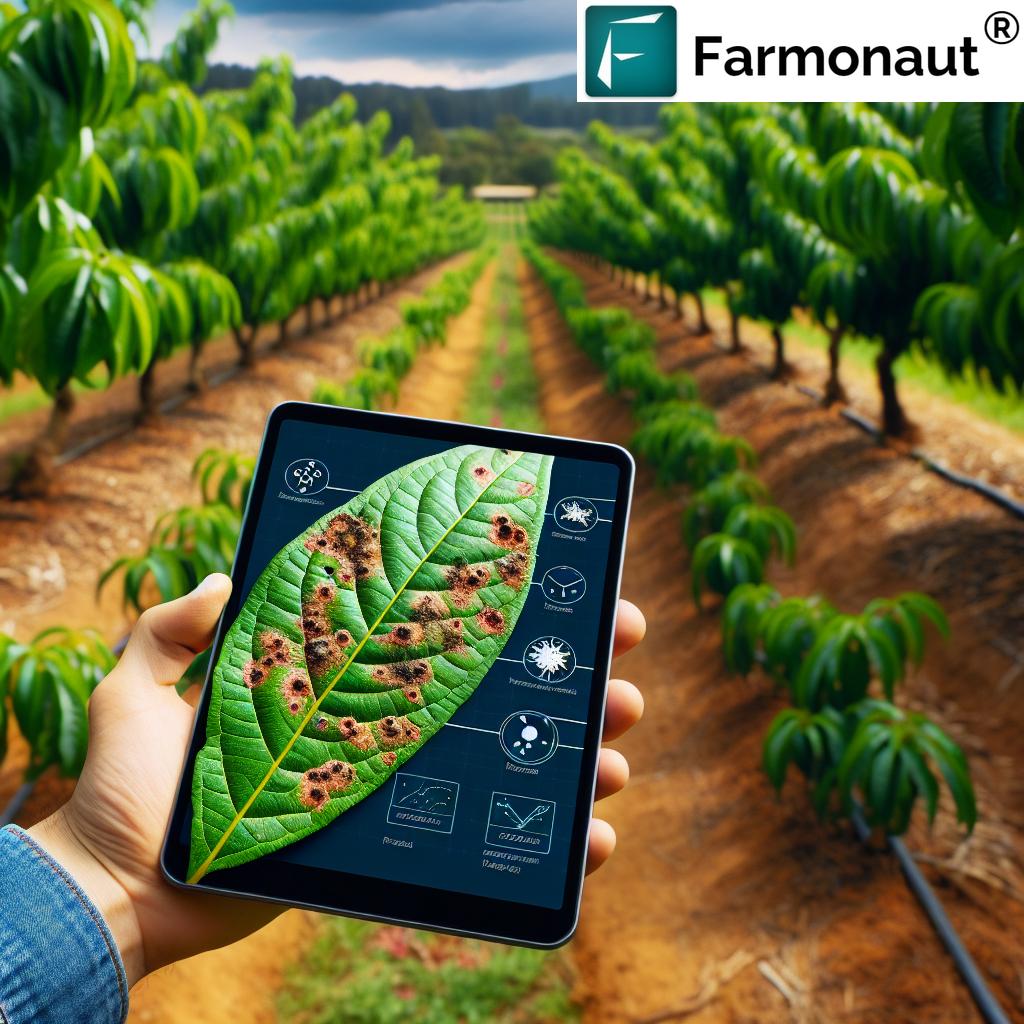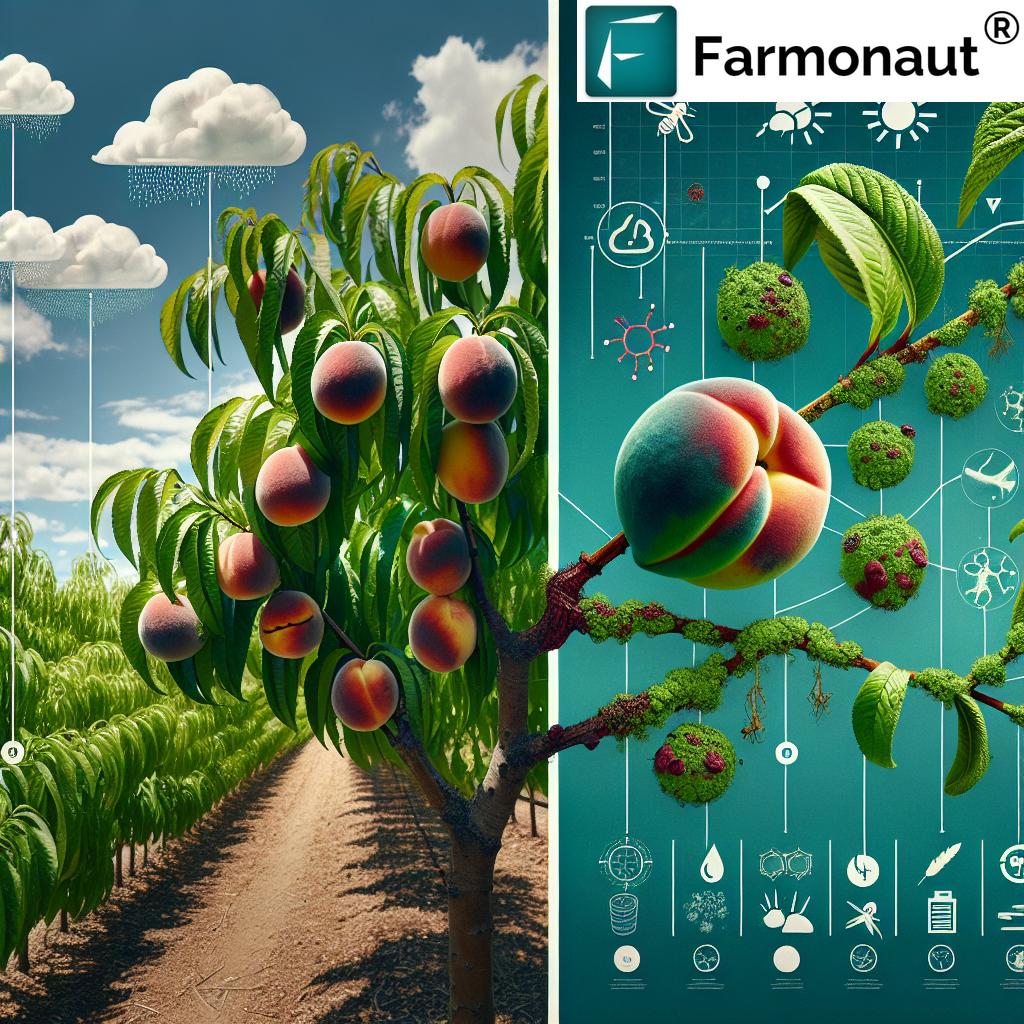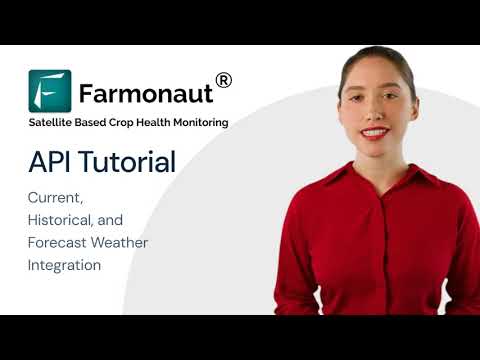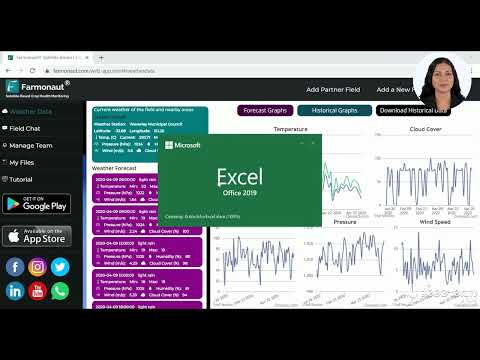Organic Pest Control: Mastering Leaf Curl Treatment for Healthy Peach Trees and Sustainable Orchard Management
“Taphrina deformans, the fungus causing peach leaf curl, can reduce fruit yield by up to 50% if left untreated.”
Welcome to our comprehensive guide on organic pest control and sustainable orchard management, with a focus on mastering leaf curl treatment for healthy peach trees. In this blog post, we’ll explore effective strategies to combat fungal diseases like leaf curl, caused by the pathogen Taphrina deformans, while promoting eco-friendly crop protection methods and precision agriculture techniques.
As advocates for sustainable agriculture practices, we understand the importance of maintaining a thriving, disease-resistant fruit tree population. Whether you’re a conventional grower or an organic farming enthusiast, this guide will provide valuable insights into fruit tree care, plant pathogen prevention, and integrated pest management strategies.

Understanding Peach Leaf Curl: The Fungal Menace
Peach leaf curl is a common and potentially devastating fungal disease that affects peach trees, as well as nectarines, almonds, and some ornamental species. The culprit behind this affliction is Taphrina deformans, a fungus that thrives in cool, moist conditions. Let’s delve into the key aspects of this pathogen:
- Infection process: The fungus infects the leaves and buds of susceptible trees, causing characteristic curling and distortion of the foliage.
- Dormancy and survival: Taphrina deformans can survive harsh summer temperatures and winter dormancy periods on the bark and branches of affected trees.
- Spore dispersal: During periods of high humidity and rainfall, the fungus releases spores that spread to new growth and neighboring trees.
Understanding the life cycle and behavior of this pathogen is crucial for implementing effective organic pest control strategies and sustainable orchard practices.
Symptoms and Impact of Peach Leaf Curl
Recognizing the early signs of peach leaf curl is essential for prompt intervention and successful treatment. Here are the primary symptoms to watch for:
- Leaf distortion: Infected leaves become thickened, puckered, and curled, often taking on a reddish or purplish hue.
- Premature defoliation: Severely affected leaves may drop prematurely, leading to reduced photosynthesis and weakened trees.
- Fruit damage: In severe cases, the disease can affect developing fruit, causing deformities and reduced yield.
- Stunted growth: Repeated infections can result in stunted shoot growth and overall tree vigor decline.
The impact of peach leaf curl on orchard productivity can be significant. Left unchecked, this fungal disease can lead to:
- Reduced fruit production and quality
- Increased susceptibility to other pests and diseases
- Long-term damage to tree health and longevity
By implementing proper fruit tree care techniques and organic pest control methods, we can mitigate these risks and maintain a healthy, productive orchard.
Weather Conditions and Disease Development
The development and spread of peach leaf curl are closely tied to weather conditions. Understanding these relationships is crucial for effective disease management and implementing climate-smart farming practices. Key factors include:
- Temperature: The fungus thrives in cool temperatures, typically between 50°F and 70°F (10°C to 21°C).
- Moisture: High humidity and prolonged periods of leaf wetness promote spore germination and infection.
- Rainfall patterns: Spring rains can facilitate spore dispersal and create ideal conditions for infection.
To stay ahead of potential outbreaks, consider utilizing advanced agricultural technology solutions like Farmonaut’s satellite-based crop monitoring system. By integrating real-time weather data and predictive models, farmers can make informed decisions about disease prevention and treatment timing.
Organic Pest Control Strategies for Peach Leaf Curl
Implementing effective organic pest control methods is essential for managing peach leaf curl while maintaining sustainable agriculture practices. Here are some key strategies:
- Cultural controls:
- Proper pruning to improve air circulation
- Removal and destruction of infected leaves and fruit
- Selection of resistant peach varieties when planting new trees
- Organic fungicides:
- Copper-based sprays (e.g., Bordeaux mixture)
- Sulfur compounds
- Neem oil preparations
- Biological controls:
- Beneficial microorganisms that compete with or inhibit the pathogen
- Compost teas and other natural soil amendments to boost tree immunity
“Proper timing of organic treatments can control 85-95% of peach leaf curl infections, significantly improving orchard health.”
Remember, the key to successful organic pest control is prevention and early intervention. Regular monitoring and timely application of treatments can significantly reduce the impact of peach leaf curl on your orchard.

Integrated Pest Management for Peach Orchards
Integrated Pest Management (IPM) is a holistic approach to crop protection that combines various control methods to minimize environmental impact while maintaining effective pest and disease management. For peach orchards, an IPM strategy might include:
- Regular monitoring: Utilize precision agriculture techniques, such as satellite imagery and ground-based sensors, to track crop health and detect early signs of disease.
- Biological controls: Encourage beneficial insects and microorganisms that naturally suppress pests and pathogens.
- Cultural practices: Implement proper irrigation, pruning, and sanitation techniques to create an environment less favorable for disease development.
- Chemical interventions: Use targeted, low-impact pesticides only when necessary and as part of a broader management strategy.
By adopting an IPM approach, orchardists can reduce their reliance on conventional chemical treatments while promoting a more balanced and resilient ecosystem within their orchards.
Leveraging Agricultural Technology for Disease Management
Modern agricultural technology solutions play a crucial role in enhancing our ability to detect, prevent, and manage diseases like peach leaf curl. Farmonaut’s advanced satellite-based monitoring system offers several benefits for orchard management:
- Early detection: Identify potential disease outbreaks before visible symptoms appear, allowing for proactive intervention.
- Precision application: Target treatments to specific areas of concern, reducing overall chemical usage and environmental impact.
- Data-driven decision making: Utilize real-time crop health data and weather forecasts to optimize treatment timing and effectiveness.
By integrating these technologies into your orchard management practices, you can improve disease control while promoting sustainable agriculture and reducing resource consumption.
Explore Farmonaut’s API for advanced agricultural data integration
Sustainable Orchard Practices for Long-term Health
Implementing sustainable orchard practices is essential for maintaining long-term tree health and productivity. Here are some key strategies to consider:
- Soil health management: Promote beneficial soil microorganisms and improve nutrient cycling through cover cropping and organic matter incorporation.
- Water conservation: Implement efficient irrigation systems and practices to reduce water usage and minimize disease-promoting conditions.
- Biodiversity enhancement: Encourage natural pest control by creating habitat for beneficial insects and birds within and around the orchard.
- Climate-smart farming: Adapt orchard management practices to changing climate conditions, including variety selection and planting schedules.
By adopting these sustainable practices, orchardists can create a more resilient and productive growing environment while minimizing their environmental impact.
Comparison of Leaf Curl Detection Methods
| Detection Method | Time Efficiency | Accuracy | Coverage Area | Early Warning Capability |
|---|---|---|---|---|
| Visual Inspection | 7-10 days for entire orchard | 70-80% detection rate | Limited by human capacity | Symptoms visible |
| Ground-based Sensors | 3-5 days for entire orchard | 85-90% detection rate | 10-50 acres per day | 3-5 days before visual symptoms |
| Farmonaut Satellite System | 1-2 days for entire orchard | 95% detection rate | 100+ acres per scan | 7-10 days before visual symptoms |
As demonstrated in the table above, Farmonaut’s satellite-based approach offers significant advantages in terms of efficiency, accuracy, and early detection capabilities compared to traditional methods. This technology enables orchardists to implement proactive disease management strategies, potentially saving time, resources, and crop yield.
Access Farmonaut’s API Developer Docs for detailed integration information
The Role of Proper Irrigation in Disease Prevention
Proper irrigation management is crucial for preventing and controlling fungal diseases like peach leaf curl. Here are some key considerations:
- Timing: Water early in the day to allow foliage to dry before nightfall, reducing the duration of leaf wetness.
- Method: Use drip irrigation or targeted sprinklers to minimize leaf wetting and reduce humidity around the tree canopy.
- Quantity: Avoid overwatering, which can create favorable conditions for fungal growth and reduce tree vigor.
- Monitoring: Utilize soil moisture sensors and weather data to optimize irrigation scheduling and efficiency.
By implementing precision irrigation techniques, orchardists can maintain optimal soil moisture levels while minimizing conditions that promote disease development.
Eco-friendly Crop Protection Solutions
In addition to organic fungicides, several eco-friendly crop protection solutions can help manage peach leaf curl and other orchard diseases:
- Biological control agents: Introduce beneficial microorganisms that compete with or parasitize pathogens.
- Plant-based extracts: Utilize natural compounds from plants with antifungal properties, such as garlic or horsetail extracts.
- Silicon supplements: Apply silicon-rich amendments to strengthen plant cell walls and increase disease resistance.
- Compost teas: Brew and apply compost extracts to boost beneficial microorganism populations on leaf surfaces.
These eco-friendly solutions can be integrated into a comprehensive organic pest control strategy, promoting orchard health while minimizing environmental impact.
Climate-Smart Farming Approaches for Peach Orchards
As climate patterns continue to shift, adopting climate-smart farming approaches becomes increasingly important for maintaining healthy peach orchards. Consider the following strategies:
- Varietal selection: Choose peach varieties that are well-adapted to your local climate and show resistance to leaf curl.
- Microclimate modification: Use windbreaks, shade cloth, or other techniques to create more favorable growing conditions.
- Soil management: Implement practices that improve soil health and water retention, such as mulching and cover cropping.
- Adaptive scheduling: Adjust planting, pruning, and treatment schedules based on changing climate patterns and weather forecasts.
By implementing these climate-smart approaches, orchardists can enhance their resilience to changing environmental conditions and maintain productive, healthy peach trees.
Maximizing Harvest Potential Through Integrated Management
To maximize harvest potential and maintain a thriving peach orchard, it’s essential to integrate various management strategies. This holistic approach includes:
- Regular monitoring: Utilize Farmonaut’s satellite-based crop health monitoring to detect early signs of stress or disease.
- Proactive treatments: Apply organic fungicides and eco-friendly solutions before disease onset, based on weather forecasts and historical data.
- Nutrient management: Maintain optimal soil fertility through regular testing and targeted amendments.
- Pruning and training: Implement proper pruning techniques to improve air circulation and reduce disease-favorable microclimates.
- Post-harvest care: Conduct thorough orchard sanitation and apply protective treatments to prepare trees for the next growing season.
By combining these strategies with advanced agricultural technology solutions, orchardists can significantly improve their chances of producing high-quality peaches while maintaining sustainable and environmentally friendly practices.
Frequently Asked Questions
Q: How often should I apply organic fungicides to prevent peach leaf curl?
A: The frequency of application depends on various factors, including weather conditions and disease pressure. Generally, it’s recommended to apply organic fungicides 2-3 times during the dormant season, with the first application in late fall and subsequent treatments in early spring before bud break.
Q: Can I use companion planting to help control peach leaf curl?
A: While companion planting can offer various benefits in an orchard system, there are no specific plant companions known to directly prevent peach leaf curl. However, introducing diverse plant species can improve overall orchard health and potentially enhance natural disease resistance.
Q: How can I incorporate Farmonaut’s technology into my orchard management practices?
A: Farmonaut offers satellite-based crop monitoring services that can be easily integrated into your orchard management. By subscribing to their platform, you can access real-time data on crop health, weather conditions, and potential disease outbreaks, allowing for more informed decision-making and timely interventions.
Q: Are there any natural predators that can help control the fungus causing peach leaf curl?
A: Unlike insect pests, fungal pathogens like Taphrina deformans don’t have natural predators in the traditional sense. However, promoting a healthy soil ecosystem with diverse beneficial microorganisms can help suppress pathogen populations and boost overall tree health.
Q: How long does it take for a peach tree to recover from leaf curl infection?
A: Recovery time can vary depending on the severity of the infection and the overall health of the tree. With proper care and treatment, mildly affected trees may recover within a single growing season. However, severe or repeated infections may take several seasons for the tree to fully recover its vigor and productivity.
Conclusion
Mastering leaf curl treatment and implementing sustainable orchard management practices are crucial for maintaining healthy, productive peach trees. By combining organic pest control methods, integrated pest management strategies, and advanced agricultural technology solutions like those offered by Farmonaut, orchardists can effectively combat fungal diseases while promoting environmental sustainability.
Remember that successful disease management requires a proactive, holistic approach. Regular monitoring, timely interventions, and adaptive management techniques are key to staying ahead of potential outbreaks and maximizing your orchard’s potential.
As we continue to face challenges such as climate change and evolving pest pressures, embracing innovative technologies and sustainable practices will be essential for the future of peach cultivation. By staying informed and implementing the strategies outlined in this guide, you’ll be well-equipped to maintain a thriving, disease-resistant orchard for years to come.
Farmonaut Subscriptions






